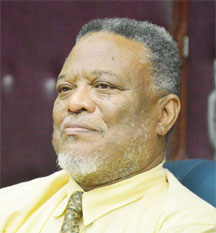An economic profile of Guyana underpinned by images of a country rich in mineral resources is no longer sustainable in the contemporary era, Prime Minister Samuel Hinds told the Stabroek Business in an exclusive interview on Wednesday.
“We have grown up with the idea of bountiful resources…that has to change. The bauxite bonanza, for example, lasted from the 1920’s to somewhere in the 1950’s. These are different times,” Hinds added.

Hinds, a 69 year-old Chemical Engineer who held Cabinet responsibility for mining and natural resources for many years, told Stabroek Business that the image of vast quantities of easily accessible mineral resources must now be replaced by an altered work ethic which attaches greater effort to securing rewards through enhanced effort.
Hinds said that Guyana’s contemporary mining sector has thrown up new challenges including those associated with the need to apply much more knowledge to the mining process. He said that while during earlier periods the mining sector was characterized by the application of limited amounts of knowledge to large quantities of minerals, the contemporary situation had reversed itself. “These days we see the application of a great deal more knowledge to fewer mineral resources. There is the requirement for more diligent work,” Hinds said. On the other hand the Prime Minister contended that the passage of time had also witnessed developments in the sector that had brought greater measures of convenience to miners. “Mining communities are now served by roads that make it easier for miners to get to work. There are other conveniences that perhaps help to offset the new challenges that they face,” he added.
In advocating a drift away from the economic paradigm of Guyana being rich in natural resources, Hinds noted that most countries that have done well since World War 11 have not had “spectacular natural resources.”
And according to Hinds extant environmental and other challenges associated chiefly with environmental considerations lie ahead for the local gold-mining sector. “Up until now small and medium scale miners had not been faced with covering the full cost of their mining operations…like environmental restoration, for example. We can no longer depend on nature to restore the environment so that the miners must fix it themselves,” Hinds said.
In his articulation of issues relating to the development of the gold-mining sector the Prime Minister said that he expected that, going forward, more emphasis would be placed on improving gold recovery methods and focusing on environmental restoration in areas that had been mined. In the latter regard he alluded to mining policies in French Guiana which place a high premium on environmental preservation in mining areas.
And according to the Prime Minister the local mining industry was also in the throes of other forms of transformation including those relating to replacing mercury as a key element in the gold recovery process. He told Stabroek Business that he believed that there were a number of “applications” that could replace mercury in the industry. Additionally, while he held the view that the costs associated with the change from mercury were not prohibitively high he believed that the real issue had to do with “knowledge and attitudes.”
And according to Hinds the country’s gold mining industry may well have crossed the hurdle of what he described some years ago as “the mining frenzy” that had been characterized by widespread environmental degradation in gold-mining communities. He said he believed that “lower gold prices may have had a stabilizing effect on the industry and that relations between coastlanders mining gold in interior regions and Amerindian host communities” had been transformed over time. He said that while in earlier times the relationship was characterized by a great deal of “challenge and conflict it had now advanced along the road of accommodation and mutual respect.” There is now a greater sense of equal citizens and today we have more Amerindians mining gold and doing well,” the Prime Minister added.
Commenting on the current downward price movement of gold on the global market Hinds said that he had, some time ago, made a call for miners to make investments in upgrading their operations to render them more efficient in anticipation of difficult times. “I believe that this has been happening though more slowly than I would have hoped.”
In his submission on the mining sector Hinds drew attention to what he said had been a shift in focus from the tradition of mining gold, diamonds and bauxite to other minerals including uranium and laterite. With regard to manganese mining, Hinds said that current “detailed studies” currently underway in the Mabaruma/Port Kaituma area are possibly a precursor to a decision that may be a year to eighteen months away from a decision to commence the creation of a manganese mine.
While Hinds provided no specifics on the current performance of the country’s bauxite under the expatriate management of the Russian and Chinese majority shareholders in the industry, RUSAL and BOSAI, respectively, he said that the intervention of foreign investors had rid the state of the onerous responsibility to subsidize the operations of the sector with amounts ranging from US$5m around 1976 to between US$10 million and US$15 million more recently. “We don’t have to do that anymore,” Hinds declared.





